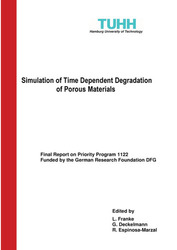| Fachbereiche | |
|---|---|
| Buchreihen (96) |
1378
|
| Nachhaltigkeit |
3
|
| Gesundheitswesen |
1
|
| Geisteswissenschaften |
2364
|
| Naturwissenschaften |
5406
|
| Ingenieurwissenschaften |
1792
|
| Allgemeine Ingenieurwissenschaften | 292 |
| Maschinenbau und Verfahrenstechnik | 862 |
| Elektrotechnik | 686 |
| Bergbau- und Hüttenwesen | 30 |
| Architektur und Bauwesen | 75 |
| Allgemein |
98
|
|
Leitlinien Unfallchirurgie
5. Auflage bestellen |
|
Erweiterte Suche
Simulation of Time Dependent Degradation of Porous Materials
Gernod Deckelmann (Autor)Rosa Espinosa-Marzal (Autor)
Lutz Franke (Autor)
Vorschau
Inhaltsverzeichnis, Datei (51 KB)
Leseprobe, Datei (140 KB)
Foreword
Porous mineral materials can be damaged by both physical and chemical attack. The
presence of an aggressive solution in the pores may induce dissolution of the porous
substrate and precipitation of damaging solids, cause chemical changes, or induce
swelling processes, all of which lead to damaging mechanical stresses and substrate
loss. These damage mechanisms can be denoted altogether as corrosion. Corrosive
processes are dependent on the moisture, the temperature, and the concentration and
nature of the carried species in the solution as well as on the flux rate at variable
concentration and other boundary conditions.
From 2002 until 2009 the DFG has financially supported our research in the field of
materials science in civil engineering, which is focused on the time-dependent
description and prediction of the cited damage mechanisms of porous mineral materials
by using numerical simulation under real field conditions. Hereby, the modeling of
microstructures and transport processes has been extensively studied.
The present book holds the reports published by the involved institutes. Each report
contains a summary of the main results achieved in their research. High mathematical
complexity and computing cost linked to thorough knowledge of physical chemistry has
been required for the successful achievement of the research goals.
Indeed, the implemented numerical models and simulation programs, some of which
are in ongoing development, provide for an increasingly useful tool to predict the
described corrosive processes in engineering and underground constructions as well as
in historic buildings.
| ISBN-13 (Printausgabe) | 3867279020 |
| ISBN-13 (Printausgabe) | 9783867279024 |
| ISBN-13 (E-Book) | 9783736929029 |
| Sprache | Englisch |
| Seitenanzahl | 416 |
| Auflage | 1 Aufl. |
| Band | 0 |
| Erscheinungsort | Göttingen |
| Erscheinungsdatum | 20.03.2009 |
| Allgemeine Einordnung | Sachbuch |
| Fachbereiche |
Architektur und Bauwesen
|








